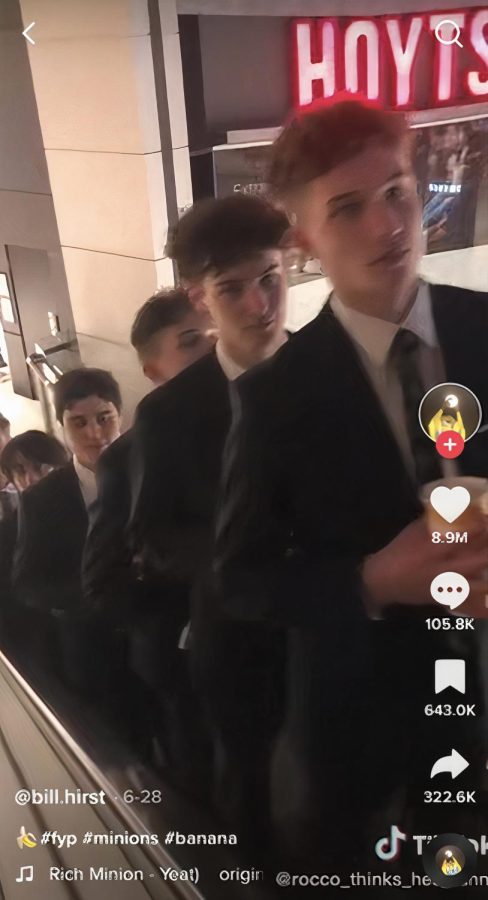Suit Up, the Wait is Over
How a TikTok Trend and the changing film industry impacted the reception of the newest Minions movie
Like any other day, you arrive at the movie theater with your family. Excited, you walk into the air-conditioned multiplex after purchasing a large popcorn at the snack bar. Just as you sit down, expecting families like yours in the audience, a tidy line of suited-up teenagers parade into the auditorium and find their seats amidst a loud cycle of pre-movie trailers. The excitement level before the big screen crescendos to something you’ve never seen before. Then, “Minions: The Rise of Gru” begins.
Released in 2010, the first Despicable Me movie introduced everyone to the lovable, overall-wearing, yellow Minions that follow around Gru, the antagonistic protagonist voiced by Steve Carell. Following two sequels and a “Minions” spinoff in 2015, the latest add-on to the Despicable Me franchise made an estimated $125 million domestically over the Fourth of July weekend, according to Universal, the company that distributed the film. With an unusually high percentage of the audience between the ages of 13 and 17 compared to previous installments of the franchise where teenagers had only made up eight percent, the film was also catapulted into the 10 highest-grossing movies of this year.
So, the question begs to be asked: Is the film’s success a result of childhood nostalgia, a big internet joke, or because it is genuinely a cinematic masterpiece?
It seems that this past summer especially was a time of film fanaticism; for longtime moviegoers who suffered from the pandemic-era withdrawal and has been kept from the cinema experience for so long, the latest installment of the most highest-grossing animated film franchise of all time seemed like a nostalgic visit. Additionally, although the Minions sequel was originally set for release in 2020, pandemic delays prompted Universal to hold off on its distribution. While other family films proceeded onto the streaming route, the company held The Rise of Gru for theaters. There were certainly people who were originally committed to seeing the Minions movie, but the film’s explosive success was undeniably also a result of a viral TikTok trend.
“TikTok, for sure, acted as an advertising tool,” noted Katherine Ge (‘24). “I haven’t seen even a fraction as much Minon-related content on other social media platforms as I’ve seen on TikTok.” On June 28, Bill Hirst, an Australian teen, posted one of the first renditions of the “#gentleminions” trend in a TikTok video that, as of August 7, sits at 38.5 million views. In total, videos with the “gentleminions” hashtag accumulate over 242 million views, in addition to the over 14 billion views of “#minions” and 1 billion views of “#riseofgru.” According to Fortune, Hirst got the idea from memes joking about showing up to the Minions movie in formal attire.
On July 1, Universal also endorsed the trend by sharing on Twitter—“to everyone showing up to @Minions in suits: we see you and we love you.” Katherine, a longtime fan of the franchise, pointed out that the movie’s marketing was truly well done. “The movie got most of Gen-Z’s favorite music artists on the soundtrack, collaborated with IHOP to produce the Minions menu, and created some pretty well-performing commercials.”
In fact, the “#gentleminions” trend even encouraged viewers to bring bananas, a Minion’s favorite food, to theaters, and steeple their hands, Gru’s signature pose, as they watch the movie. TikTok videos also promoted enthusiastic clapping throughout the viewing experience, which in some cases, incited backlash. Disruptive viewing behaviors have led many UK cinemas, such as the Odeon chain, to discourage these displays; one cinema in Wadebridge, Cornwall, even banned unaccompanied suit-wearing children from watching the movie. “Due to recent disturbances following the #GentleMinions trend,” Odeon cinemas’ warning signs said, “any group of guests in formal attire will be refused entry for showings…”
It’s hard to deny the TikTok trend’s impact on the frenzied success of “Minions: The Rise of Gru.” With easy-to-access tools like hashtags to repeatedly spread various challenges, jokes, and pop-up discourses, the short-video-dominated social media platform engages audiences easily. Perhaps TikTok’s iron grip on the current climate of our pop culture is spreading quickly to the film industry—in 2021, 69% of the platform’s users have posted content related to a show or movie, according to a TikTok Entertainment Study.
“To me, TikTok reminds me of commercial breaks on TV that are directed at children to make them ask for a certain toy for their birthday or near Christmas-time,” observed Emeraude Westlake (‘24). “Except instead of making the ad specifically appealing to children, Tiktok’s algorithms and style make it appealing to multiple generations.”
When asked about this spectacle of a phenomenon, Daxton Gutekunst (‘23), whose decision to watch the movie was influenced by the trend, noted: “It certainly gets people watching something they wouldn’t normally watch.” He then paralleled TikTok’s advertising tactics with those of name brands on Twitter. Advertising has always been so intertwined with culture, and Twitter was one such place that fostered a new sense of intimacy between brands and their audiences. By googling ‘funniest brand accounts on Twitter,’ you’ll find countless compilations of brands like Wendy’s tweeting at random users. Daxton continued, “I think something similar is beginning to happen in the film industry, where those behind the scene are finding ways to interact more and more with a certain generation of audience.”
But this unprecedented hold on the movie industry, like many things online, may be impermanent. “Tiktok will help create high-grossing movies because there are millions of high-grossing TikToks,” said Emeraude. “I don’t know how long this will last though, because, maybe the mindset will shift to: “If I can watch the fun part of the movie on Tiktok, why bother going to the theater?”
Another much-debated question follows: is the Minion’s success a coincidence? Could this have happened with any children’s movie thanks to clever advertising innovations?
“I think part of [the advertising success] is because we know the Minions so well,” Daxton noted, thinking back to the 2010 release of the first movie. “The franchise is just so ridiculously absurd—I mean, you’re going in suits to a children’s movie.” Katherine added, “Nostalgia definitely played a role. Minions were a central part of our childhoods, and at this point, they’ve become cultural artifacts rather than just characters.”
Whether it was the growing accessibility of trends, marketing geniuses, or just sweet childhood nostalgia, the newest installment of the Despicable Me franchise spelled massive success financially and culturally. “Dressing up for the movie began as something ironic, but over time, I began to understand it as something people had genuine fun with,” said Katherine. With the world’s eyes on these banana-loving icons, perhaps TikTok’s increasing hold on the film industry will be a norm for the near future.

Crystal Li joined The Tower in her freshman year when she moved from Shanghai to San Diego in 2019. Now a senior, she fondly looks back on the four-year...


